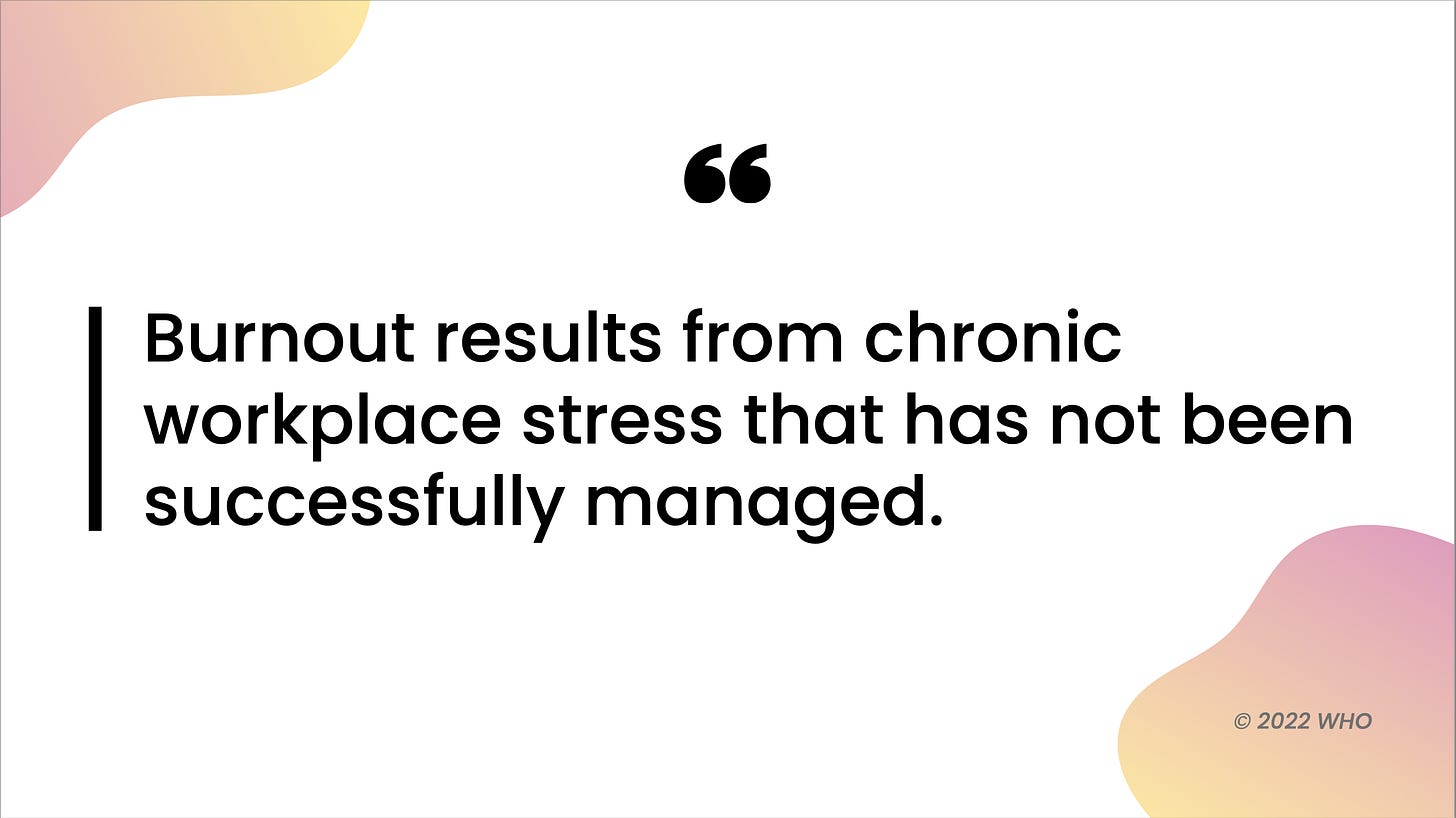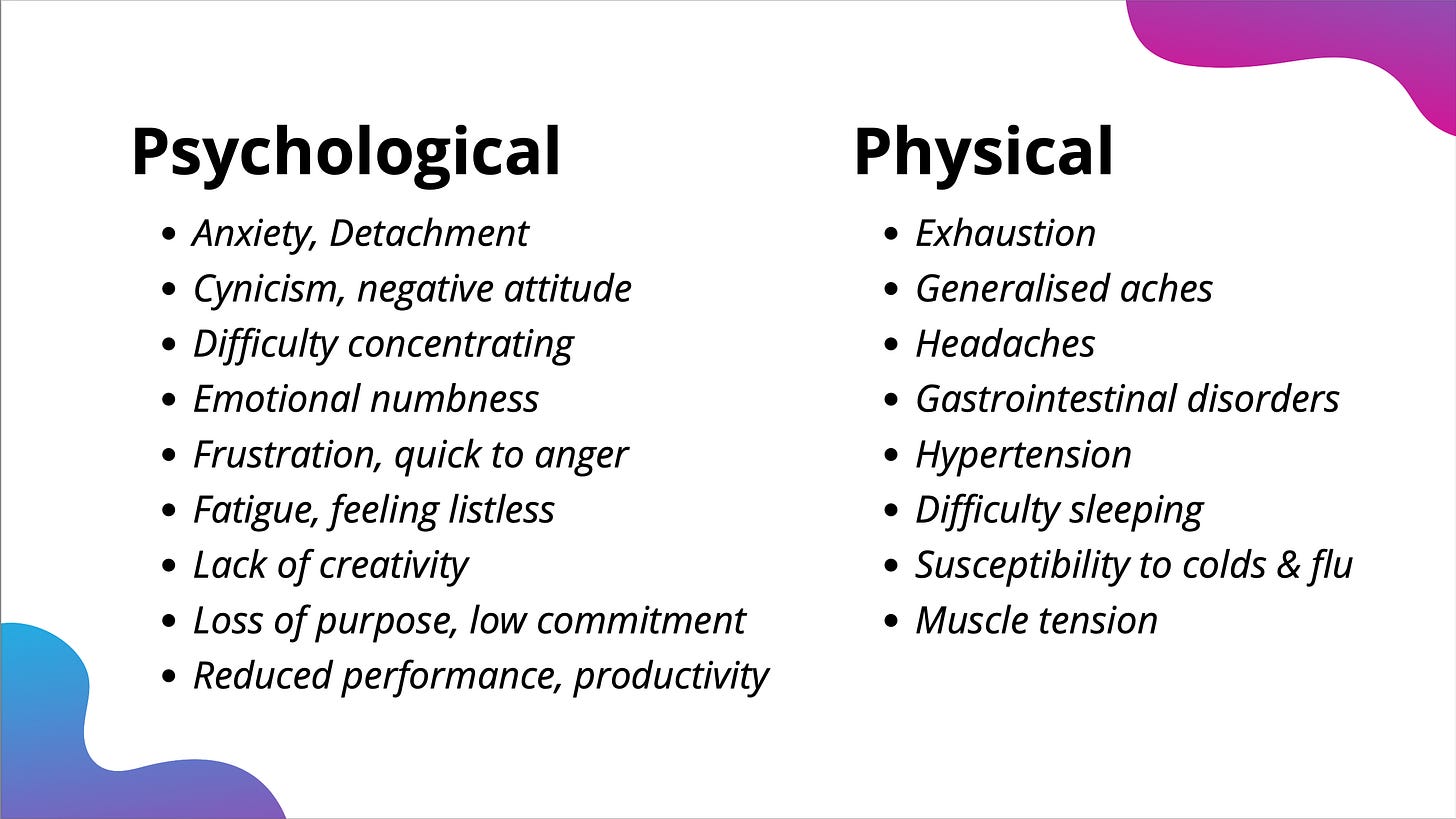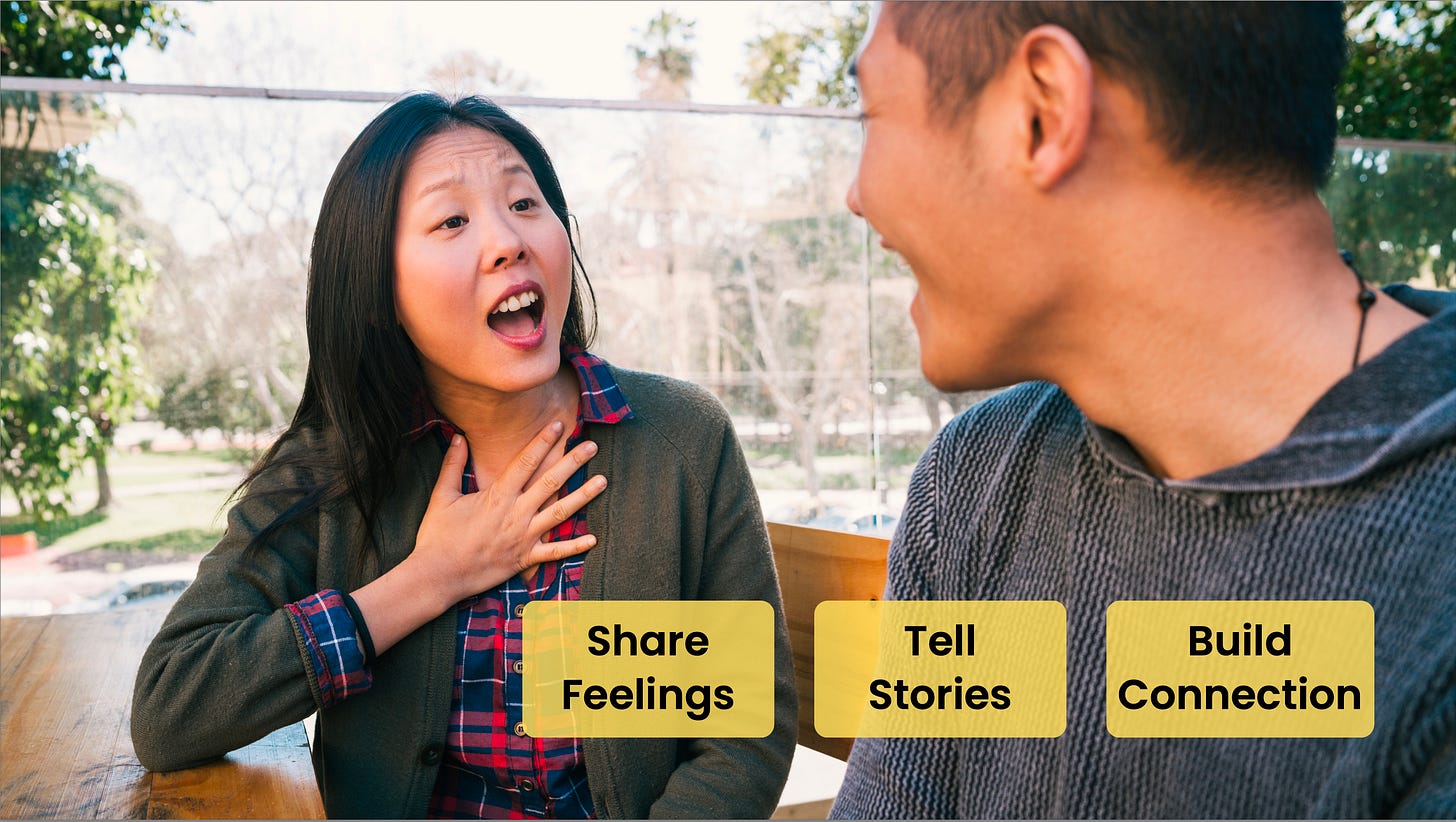Navigating the Burnout Epidemic
From personal experience to collective healing, burnout is a social issue of the modern era and we have to figure out how to talk about it together.
We think we know what burnout is.
We hear the phrase in social media, online writing, and casual conversation.
It almost seems trendy, but the reality of burnout is far from it. Until you’ve felt the overwhelming weight pressing down on you, it’s hard to fully comprehend. For me, burnout built up gradually over years—until one day I found myself desperate to escape.
That’s when I tried to quit a job I’d worked years to achieve.
Looking back, there were a few early signals:
Avoidance, where I preferred to work alone, feeling disconnected from my work and my colleagues.
Impatience, with a lack of energy to explain myself to the people around me.
Exhaustion, not managing my energy well enough to engage in after-work activities.
Numbing, a desire to escape my own thoughts, leading to patterns of numbing (e.g. doomscrolling, doomstreaming, retail therapy, alcohol, drugs, etc.)
That said, I can point to these much more clearly in hindsight. In the moment, these felt like symptoms of a “bad day at work.” Because our working world tends to value hard work, we adopt a belief that we should just “power through” these experiences. But that doesn’t really work.
My co-workers noticed before I did, pointing out that I was frequently late or absent. Then, someone asked me a question that caught my attention: “What if your body feels sick as a reaction to what’s going on in your mind?” This was my first "aha" moment. I was indeed in too deep, calling in sick, avoiding people at the office, disengaged from my work.
Yet, this all just felt like criticism and I stuffed it down to deal with later. After ignoring this for too long, my body & mind kicked into survival mode. That’s when I walked into the office and called an emergency meeting with my boss. All I could communicate was, “I just can’t be here anymore.”
Instead of the reactions I expected – sadness, anger, disgust – I received acceptance. In a profound demonstration of conscious leadership, my boss said:
"It sounds like you're in a difficult place. I'd hate for you to make this decision when you're not feeling yourself.”
My boss and my HR business partner suggested that I take some time to recover. The company was willing to support me going on medical leave if I could get a psychiatrist to diagnose my situation. I was diagnosed with clinical depression and granted three months of paid medical leave, allowing me to come back to my dream job later.
October 2019 marked the beginning of my medical leave. Initially, I was overwhelmed by my depression and struggled to get out of bed. Eventually, I found myself in therapy, trying antidepressants, and starting my journey with mindfulness and meditation.
Therapy illuminated my experiences, labeling and redefining them in a new light. As my recovery progressed, I shared my journey with the people around me. This simple act of opening up revealed the pervasive nature of burnout, and further fueled my recovery.
(This experience put me on a path to where I am today, running my own business where I help people identify and manage the effects of burnout, while building their own sense of resilience.)
Following three months of recovery, I cautiously returned to the office in January 2020. Respect for privacy meant that few knew the reasons for my absence. While I could have manipulated the narrative, I chose transparency, hoping to inspire others confronting similar situations by demonstrating the myriad ways of dealing with it.
Then, fate played its hand. Barely eight weeks had passed before the office shifted to remote work in early March due to COVID-19. The initial weeks morphed into years, and the aftereffects of this seismic shift are still reverberating through our lives.
Even before COVID-19, burnout was a prevalent issue. But now, the risks have escalated due to our extended isolation, the economic strain pushing us to "do more with less," and the chaos, division, and uncertainty dominating our world view. These factors amplify burnout, making it one of the paramount challenges of our era.
We must stand together, fostering a collective understanding that no one is alone in their struggle. It begins with each of us. Here's how you can make a difference:
Recognize burnout when it’s happening
Share your experience with others
Support those who may be struggling in silence
First, let's define burnout:
The World Health Organization describes burnout as the result of "chronic workplace stress that has not been successfully managed.”
Burnout can be characterized in three key dimensions:
Feelings of energy depletion, or exhaustion
Increased mental distance from one’s job, or negative feelings related to work
Reduced professional efficacy
It’s essential to understand that “burnout” is not a medical diagnosis. You can’t visit a doctor or psychiatrist for a "burnout" diagnosis. Instead, it manifests as a variety of psychological impacts, leading to physical symptoms.
Take a moment to reflect on these symptoms. They could be remnants of the collective trauma from COVID-19 or signs of burnout. Amid the rush to "go back" to normalcy, we often neglect to process the lessons from our experiences.
Did you know nearly 77% of professionals have experienced burnout at their current job? That means more than three-quarters of us have experienced debilitating exhaustion, creeping cynicism, and growing detachment from our work and ourselves. This is a rampant issue, damaging both individuals and organizations.
However, you can steer clear from becoming another statistic. With the right tools, you can mitigate or recover from burnout. Here are some proactive measures to restore your equilibrium:
Mindfulness: This isn't just a fashionable buzzword; it's a powerful instrument to nurture awareness and acceptance. Regularly engaging in mindfulness exercises allows us to introspect our mental and physical wellbeing. Techniques such as breathing exercises can halt the relentless stream of thoughts, allowing us to focus on our present experience.
Self-assessment: Regularly evaluate your mental state. Are you displaying burnout symptoms? Or are you recovering? Learning to identify your feelings and emotions is crucial. If you're uncertain about labeling your emotions, the Emotions & Feeling Wheel can be a valuable resource.
Healthy communication: An increased awareness of your state of mind can help you establish boundaries, express yourself, and seek assistance when needed.
Familiarizing yourself with your internal experiences will make it easier to identify the days when you feel "off." Top athletes and successful CEOs often use "The Rule of Thirds" to frame these experiences:
33% of the time you feel invigorated
33% of the time you feel neutral
33% of the time you feel demotivated
This even distribution is normal. But if it tilts towards feeling dejected most of the time, it could indicate fatigue or burnout.
Despite these insights, discussing anxiety, depression, and burnout, especially in a workplace, remains challenging due to lingering stigma. It hampers our collective recovery and resilience-building process.
So, here's my earnest request: Share your experience.
Revealing your journey to others can foster connections that help us combat workplace burnout collectively.
To do this, you can:
Share your feelings and experiences with trusted confidants.
Narrate your personal encounters with burnout to stimulate conversations.
Build connections — shared experiences remind us we're not alone in our struggles and offer solace to others.
Remember, it's crucial to share your own experiences rather than giving unsolicited advice. Phrases like "when I had this happen.." or "when I felt that way I saw a therapist" can resonate more with others.
Sharing experiences often prompts others to reciprocate. If you know someone struggling with burnout, try to lend them a compassionate perspective. I recall how a simple act of listening helped me connect my physical symptoms to my stress levels.
Should you or anyone you know need it, don't hesitate to seek professional help. Numerous resources are available for different stages of burnout, ranging from talking to your boss or an HR representative to seeking mental health support from a therapist or mental health coach. It's okay not to be okay.
The journey towards recovery isn't a cakewalk, but remember, meaningful journeys seldom are. Stay open-minded, eager to learn, and seek continuous improvement. Most importantly, remember you're not alone on this path.
If you’d like to explore some of the resources I’ve accrued for people experiencing burnout, check out the Burnout & Resilience section of my public resource wiki.











Many people talk about experiencing burnout, but it's rare for someone to have the courage to describe their own experience in detail. Thank you for sharing your story, Ryan.